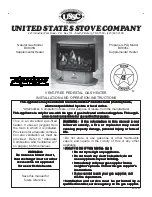
14
78570
Managing Heat Output
The heat output from the appliance can be controlled by the
position of the flue damper on vented fireplaces.
The damper setting should be fully closed for maximum heat
output, partially closed for less heat output and fully open for
minimum heat output.
The appliance may be used in a working solid fuel burning
fireplace with the fuel damper closed only if unvented appli-
ances are permitted by local state and city codes. It may also
be operated as a decorative appliance whose prime function
lies in the aesthetic effect of the flames when installed in a solid
fuel burning fireplace with the flue damper open. If unvented
heaters are not permitted, the fireplace vent damper must be
locked at a minimum free (vent) area of 15 sq. ins.
Whenever the appliance is operated with the fireplace's
flue damper closed, glass doors - if present - must be open
and the outside air damper and the ash dump (if the
fireplace is equipped with either one) must be closed.
The heat output from the appliance when operated as a vent-
free heater may be controlled by adjusting the main gas valve.
Reference lighting instructions on Page 11 and chart on Page 3
which shows inputs at all settings.
The main gas valve may be adjusted anywhere between high
and low to give the desired combination of flame aesthetics and
heat output.
Maintenance
Cleaning
CAUTION: Before cleaning or moving logs or other parts of the
unit, be sure to read the section on important safeguards.
Cleaning should be done before the logs are used each year
and after long periods of non-use. Professional servicing is
recommended.
All cleaning should be carried out when the appliance is cold.
Only limited cleaning will be required under normal use.
Dusting the front grate or the control knob panel may be
required occasionally. Do not use any cleaning fluids to clean
the logs or any other part of the appliance.
If the flames show any unusual shapes or behavior, or if the
burner(s) fail to ignite properly, then the burner holes may
require cleaning. If this occurs contact your nearest dealer to
get the appliance serviced.
Alternatively, the appliance can be cleaned by removing the
logs. Handle the logs gently so as not to damage them.
Always lift each log by holding it carefully at each end.
After the logs are removed allowing access to the burner area,
use the brush attachment from your vacuum cleaner to carefully
remove dust and loose particles from the base, logs and from
around the burner. Gloves are recommended when handling
the logs. Use extreme caution when cleaning around the pilot
(ODS). The pilot should not be moved or altered from the
original factory setting (Pilot to burner preset location). To clean
the pilot, take an Air Duster can (computer cleaner compressed
air) and insert the nozzle into the primary air inlet. Shoot a
short blast of air into the inlet to clear dust. (Fig. 20) The burner
should not be removed or taken out of it’s locked and secure
position (proper location of burners are critical).
Logs must be carefully replaced in their orignial, preset posi-
tions, as shown in Figure 21, to prevent the rear flames from
touching any log. No other arrangement is permitted. Incorrect
placement can diminish combustion efficiency and cause
sooting.
A qualified gas professional should periodically check and clean
the orifices and burners per National Fuel Gas Code, Appendix
B.
Lack of proper maintenance may void warranty.
Gas
Outlet
Primary Air
Inlet
T135
Fig. 20 Use a short burst of air into the primary air inlet to clean
pilot.
Fig. 21 Correct log placement.
Rear Log
Right Twig
Left Twig
Front Log
TL106






































